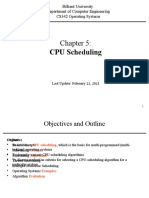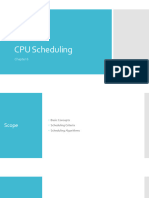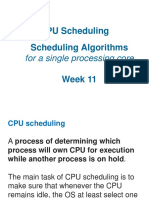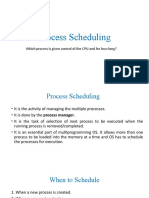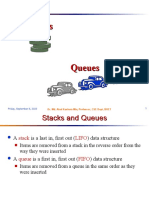Computer Systems II
CPU Scheduling
Review of Process States
1
�OS Queuing Model
Enter Ready queue CPU Exit
Disk Queue
Network Queue
Printer Queue
Processes enter and leave the system
CPU Scheduling
Each process in the pool of ready
processes is ready to run.
Which one to pick to run next?
CPU scheduling
- Selecting a new process to run from the
Ready queue
2
�Types of Scheduling
Preemptive scheduling
- Running process may be interrupted and moved
to the Ready queue
Non-preemptive scheduling:
- once a process is in Running state, it continues
to execute until it terminates or blocks for I/O
When Does a Scheduler Take Decisions?
When a process:
1. Switches from running to waiting state.
2. Switches from running to ready state.
3. Switches from waiting to ready.
4. Terminates.
Scheduling under 1 and 4:
- Non-preemptive scheduling
Scheduling under 2 and 3:
- Preemptive scheduling
3
� CPU-bound vs. I/O –bound
Processes
The CPU-I/O Burst Cycle
Maximum CPU utilization obtained with
multiprogramming.
CPU-I/O Burst Cycle
- Process execution consists of a cycle of CPU
execution and I/O wait.
Each cycle consists of a CPU burst followed
by a (usually longer) I/O burst.
A process terminates on a CPU burst.
4
�Alternating CPU and I/O Bursts
Basic Concepts
Burst/Service time = total processor time
needed in one CPU-I/O burst cycle.
Jobs with long CPU burst time are CPU-bound
jobs and are also referred to as “long jobs”.
Jobs with short CPU burst time are I/O-bound
jobs and are also referred to as “short jobs”.
CPU-bound processes have longer CPU
bursts than I/O-bound processes.
10
5
�Long vs. Short CPU Burst
11
Uniprocessor Scheduling
We concentrate on the problem of scheduling
the usage of a single processor among all the
existing ready processes in the system.
What goals are we trying to achieve?
13
6
�Scheduling Criteria
CPU utilization – keeping CPU as busy as possible.
Throughput – # of processes that complete their
execution per time unit.
Turnaround time – amount of time to execute a
particular process from start to end.
Waiting time – amount of time a process has been
waiting in the ready queue.
Response time – amount of time it takes from when
a request was submitted until the first response is
produced (for time-sharing environment).
14
Classification of Scheduling Criteria
User-oriented:
- Response Time: elapsed time from the submission
of a request to the beginning of response
- Turnaround Time: elapsed time from the
submission of a process to its completion
System-oriented:
- CPU utilization
- Throughput
- Fairness
15
7
�Optimization Criteria
Max CPU utilization
Max throughput
Min turnaround time
Min waiting time
Min response time
Conflicting criteria!
16
Scheduling Algorithms
FCFS
RR
SPN / PSPN
Priority
8
�Scheduling Algorithms
Next we take a look at four scheduling algorithms
and their amusing behavior
1. First Come First Served – FCFS
2. Round Robin – RR
3. Shortest Process Next – SPN, PSPN
4. Multi-Level Feedback (Priority)
Scheduling very ad hoc. “Try and See”
18
First Come First Served (FCFS or FIFO)
Simplest scheduling algorithm:
- Run jobs in order that they arrive
- Scheduling mode: non-preemptive
- In cases of I/O requests, place job at back of
Ready queue when I/O completes
Advantage: simple
Disadvantages: ???
19
9
�FCFS Example
Process Arrival Time CPU Burst Time
P1 0 3
P2 2 6
P3 4 4
P4 6 5
P5 8 2
A. Frank - P. Weisberg
20
A Simpler FCFS Example
Process CPU Burst Time
P1 24
P2 3
P3 3
Processes arrive at time 0 in the order: P1 , P2 , P3
FCFS Scheduling:
P1 P2 P3
0 24 27 30
Waiting time for P1 = 0; P2 = 24; P3 = 27
Average waiting time: (0 + 24 + 27) / 3 = 17
Average turnaround time: (24+27+30)/3 = 27
21
10
�A Twist on the FCFS Example
What if the processes arrive in the order
P2 (3), P3 (3), P1 (24)
The scheduling chart is:
P2! P3! P1!
0! 3! 6! 30!
Waiting time for P1 = 6; P2 = 0; P3 = 3
Average waiting time: (6 + 0 + 3)/3 = 3
Average turnaround time: (3+6+30)/3 = 13
Long processes love FCFS; short processes DON’T!
22
FCFS Disadvantage
Short processes may
be
stuck
behind long processes
(Convoy effect)
23
11
�Round Robin (RR) Add a timer"
Solution to job monopolizing CPU? Interrupt it.
- Run process for some “time quantum” (time slice)
- When time is up, move it to the back of the Ready queue
- Most systems do some flavor of this
Advantages:
- Fair allocation of CPU across jobs
- Low average waiting time when job lengths vary:
- Assume P1(24), P2(3), P3(3) and time quantum = 1
1 2 3 4 5 6 7 8 9 30
P1 P2 P3 P1 P2 P3 P1 P2 P3 P1
- What is the average waiting / turnaround time?
24
A Twist on the RR Example
What if the processes have similar sizes? Assume 2
processes of 24 time units each:
1 2 3 4 5 6 7 47 48
P1 P2 P1 P2 P1 P2 P1 P1 P2
- What is the average missed time?
- What is the average completion time?
- How does it compare to FCFS for the same two
processes?
25
12
� Same RR Example with Time Slice = 4
Two processes of 24 time units each, time slice = 8
8 16 24 32 40 48
P1 P2 P1 P2 P1 P2
- What is the average waiting time?
- What is the average turnaround time?
- How does it compare to FCFS for the same two
processes?
Main interesting thing is the length of the time slice
26
Round Robin’s BIG Disadvantage
Performance depends
on
the sizes of processes and
the length of the time slice
27
13
�RR Time Slice Tradeoffs
Scheduling involves context switching
Job 1 Job 2
Timeslice too high
- you get FCFS Running Blocked
Save context
..
.
Timeslice too low Load context
- most of the time Blocked Running
spent on context
switching Save context
..
.
Running Load context Blocked
28
RR Time Slice Tradeoffs
Timeslice frequently set to ~100 milliseconds
Context switches typically cost < 1 millisecond
- context switching is usually negligible (< 1% per
timeslice in above example) unless you context
switch too frequently and lose all productivity.
29
14
�Shortest-Process-Next (SPN, PSPN)
Associate with each process the length of its
next CPU burst.
Select the process with the shortest next CPU
burst time.
Also called Shortest Job First (SJF) and
Shortest Time First (STF).
I/O bound processes will be picked first.
SPN is optimal – gives minimum average
waiting time for a given set of processes.
30
Shortest-Process-Next (SPN, PSPN)
Requires explicit information about the service-time
requirements for each process. Use this information
to schedule the process with the shortest time.
Nonpreemptive
- Once CPU is given to a process, it cannot be
preempted until it completes its CPU burst.
Preemptive
- If another process arrives with a total CPU time
requirement less than the remaining CPU time
required by the running process – preempt!
31
15
�SPN Example (Non-preemptive)
Process Arrival Time CPU Burst Time
P1 0 3
P2 2 6
P3 4 4
P4 6 5
P5 8 2
32
Another SPN Example
3 processes, P1(24), P2(3), P3(3)
3 6 30
P2 P3 P1
- Average turnaround= (3+6+30) / 3 = 13
(compare with 27 for FCFS)
Provably optimal
- Moving shorter process before longer process improves
waiting time of short process more than harms waiting time
for long process
33
16
�PSPN Example (Preemptive)
Process Arrival Time CPU Burst Time
P1 0 3
P2 2 6
P3 4 4
P4 6 5
P5 8 2
34
PSPN is Optimal but Unfair
Gives minimum average missed time
However:
- Long jobs may starve if too many short jobs
35
17
�Determining Length of Next CPU Burst
Can be done by using the length of previous
CPU bursts, using exponential averaging:
1. tn = actual length of n th CPU burst
2. en+1 = expected value for the next CPU burst
3. α, 0 ≤ α ≤ 1
4. Define:
en+1 = α tn + (1− α ) en
38
Examples of Exponential Averaging
How to set α in en+1 = α tn + (1− α ) en
α=0
- en+1 = en
- Recent history does not count
α=1
- en+1 = tn
- Only the actual last CPU burst counts
Let’s be balanced: α = 0.5
39
18
�Idea of Exponential Averaging
If we expand the formula, we get:
τn+1 = α tn+(1 – α) α tn-1 + …
+(1 – α )j α tn-j + …
+(1 – α )n+1 τ0
Since both α and (1 – α) are less than or equal to 1,
each successive term has less weight than its
predecessor; term weights decrease exponentially.
Exponential averaging here is better than simple
averaging.
40
Priority Scheduling
A priority number is associated with each process.
The CPU is allocated to the process with the highest
priority (smallest integer = highest priority).
SPN is a priority scheduling where priority is the
predicted next CPU burst time.
Problem: Starvation – low priority processes may
never execute.
Solution: Aging – as time progresses, increase the
priority of the process.
41
19
�Multi-Level Feedback (FB)
Split the Ready list into a number of queues:
queue 0, queue 1, queue 2, and so on.
Lower-numbered queues have higher priority.
When the current process is interrupted at the end of
its quantum, a new process is selected from the front
of the lowest-numbered queue that has any processes.
After a process has used a quanta in its queue, it is
placed at the end of the next-higher numbered queue.
The word “feedback” refers to the fact that processes
can move from one queue to another.
42
FB Variants
Let the quantum size depend on the queue. A queue
numbered n could have a quantum of length 2n q , where
q is the ‘‘basic quantum’’ size. Therefore, the queues
have quanta of sizes q , 2q , 4q , 8q , and so on.
Let a process in queue use several quanta before being
demoted to the next queue
Promote a process to a higher-priority queue after it
spends a certain amount of time waiting for service in its
current queue.
Instead of granting absolute priority to low-numbered
queues, grant slices of time to each queue, with lower-
numbered queues receiving larger slices.
46
20
�FB Variants
Scheduler defined by the following parameters:
- number of queues
- scheduling algorithms for each queue
- method used to determine when to upgrade a process
- method used to determine when to demote a process
- method used to determine which queue a process will
enter when that process needs service
Windows Operating System
- 32 priority levels
- Decrease priority at timer interrupts
- Increase priority at I/O events
47
Traditional UNIX Scheduling
Uses multilevel feedback queues
128 priorities possible (0-127)
One Round Robin queue per priority
At every scheduling event, the scheduler
- picks the non-empty queue of highest priority
- runs processes in round-robin
Scheduling events:
- Clock interrupt
- Process does a system call
- Process gives up CPU (for instance, to do I/O)
48
21
�Traditional UNIX Scheduling
All processes assigned a baseline priority based on
the type and current execution status:
- swapper 0
- waiting for disk 20
- waiting for lock 35
- user-mode execution 50
At scheduling events, priorities are adjusted based
on the amount of CPU used, the current load, and
how long the process has been waiting
49
Linux - Lottery Scheduling
Give each process some number of tickets
At each scheduling event, randomly pick a ticket
Run winning process
More tickets implies more CPU time
How to use?
- approximate priority: low priority à give few
tickets; high priority à give many tickets
- approximates SRT: short processes à give
more tickets; long processes à fewer tickets
If a job has at least one ticket, it won’t starve
50
22
� Summary
FCFS:
- Advantage: simple
- Disadvantage: short jobs can get stuck behind long ones
RR:
- Advantage: better for short jobs
- Disadvantage: poor when jobs are the same length
SPN / PSPN:
- Advantage: optimal
- Disadvantages: hard to predict the future;
unfair to long running jobs
Multi-level feedback:
- Advantage: approximates PSPN
- Disadvantage: still a bit unfair to long running jobs
23

